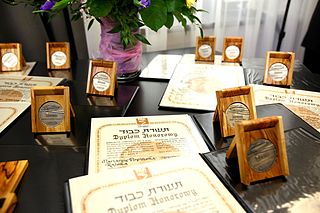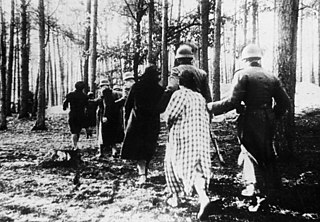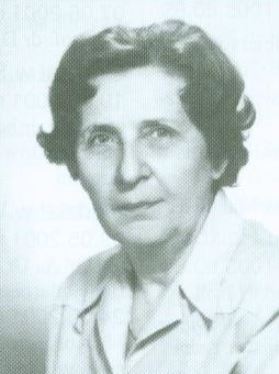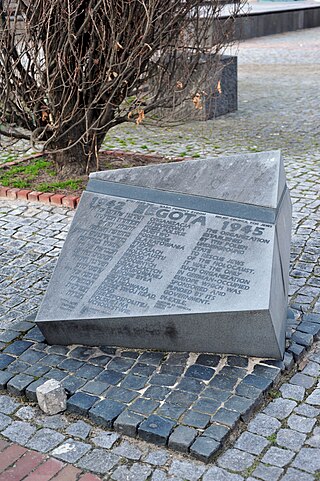Related Research Articles

Żegota was the Polish Council to Aid Jews with the Government Delegation for Poland, an underground Polish resistance organization, and part of the Polish Underground State, active 1942–45 in German-occupied Poland. Żegota was the successor institution to the Provisional Committee to Aid Jews and was established specifically to save Jews. Poland was the only country in German-occupied Europe where such a government-established and -supported underground organization existed.

Płońsk is a town in central Poland with 21,591 inhabitants (2022). Situated at the Płonka river in the historic region of Mazovia, it is the seat of Płońsk County in the Masovian Voivodeship.

Lubartów Ghetto was established by Nazi Germany in occupied Poland during World War II, and existed officially from 1941 until October 1942. The Polish Jews of the town of Lubartów were confined there initially. The ghetto inmates also included Jews deported from other cities in the vicinity including Lublin and Ciechanów and the rest of German-occupied Europe for the total of 3,500 Jews in its initial stages including 2,000 Jews from Slovakia. In May 1942 additional transport from Slovakia with 2,421 Jews arrived.

The citizens of Poland have the highest count of individuals who have been recognized by Yad Vashem as the Polish Righteous Among the Nations, for saving Jews from extermination during the Holocaust in World War II. There are 7,232 Polish men and women conferred with the honor, over a quarter of the 28,217 recognized by Yad Vashem in total. The list of Righteous Among the Nations is not comprehensive and it is estimated that hundreds of thousands of Poles concealed and aided tens of thousands of their Polish-Jewish neighbors. Many of these initiatives were carried out by individuals, but there also existed organized networks of Polish resistance which were dedicated to aiding Jews – most notably, the Żegota organization.
Siedliska is a village in the administrative district of Gmina Miechów, within Miechów County, Lesser Poland Voivodeship, in southern Poland. It lies approximately 3 kilometres (2 mi) north of Miechów and 36 km (22 mi) north of the regional capital Kraków.

The family of Franciszek and Magdalena Banasiewicz and their children Jerzy, Tadeusz, Antoni, and Maria lived on a farm in Orzechowce near Przemyśl during the Nazi German occupation of Poland in World War II. In July 1991 they were bestowed the titles of Righteous among the Nations by Yad Vashem for rescuing fifteen Jews escaping the Holocaust from the ghetto in Przemyśl.

Polish Jews were the primary victims of the Nazi Germany-organized Holocaust in Poland. Throughout the German occupation of Poland, Jews were rescued from the Holocaust by Polish people, at risk to their lives and the lives of their families. According to Yad Vashem, Israel's official memorial to the victims of the Holocaust, Poles were, by nationality, the most numerous persons identified as rescuing Jews during the Holocaust. By January 2022, 7,232 people in Poland have been recognized by the State of Israel as Righteous among the Nations.

The Będzin Ghetto was a World War II ghetto set up by Nazi Germany for the Polish Jews in the town of Będzin in occupied south-western Poland. The formation of the 'Jewish Quarter' was pronounced by the German authorities in July 1940. Over 20,000 local Jews from Będzin, along with additional 10,000 Jews expelled from neighbouring communities, were forced to subsist there until the end of the ghetto history during the Holocaust. Most of the able-bodied poor were forced to work in German military factories before being transported aboard Holocaust trains to the nearby concentration camp at Auschwitz where they were exterminated. The last major deportation of the ghetto inmates by the German SS – men, women and children – between 1 and 3 August 1943 was marked by the ghetto uprising by members of the Jewish Combat Organization.

The Ulma family or Józef and Wiktoria Ulma with Seven Children were a Polish Catholic family in Markowa, Poland, during the Nazi German occupation in World War II who attempted to rescue Polish Jewish families by hiding them in their own home during the Holocaust. They and their children were summarily executed on 24 March 1944 for doing so.

The Palmiry massacre was a series of mass executions carried out by Nazi German forces, during World War II, near the village of Palmiry in the Kampinos Forest northwest of Warsaw.

The Nowy Sącz Ghetto known in German as Ghetto von Neu-Sandez and in Yiddish as צאנז or נײ-סאנץ was a World War II ghetto set up by Nazi Germany for the purpose of persecution and exploitation of Polish Jews in the city of Nowy Sącz pronounced[ˈnɔvɨˈsɔnt͡ʂ] during the occupation of Poland (1939–45).

During the Holocaust in Poland, 1939–1945, German occupation authorities engaged in repressive measures against non-Jewish Polish citizens who helped Jews persecuted by Nazi Germany.
During the German occupation of Poland, citizens of all its major ethnic groups collaborated with the Germans. Estimates of the number of collaborators vary. Collaboration in Poland was less institutionalized than in some other countries and has been described as marginal, a point of pride with the Polish people. During and after the war, the Polish government in exile and the Polish resistance movement punished collaborators and sentenced thousands of them to death.

Maria Rogozińska née Leśniak was a Polish farmer, living in the village of Wierbka near Pilica, together with her three-year-old son. She was murdered by the Germans for hiding Jews and was posthumously awarded the "Righteous Among the Nations" medal.
Executions in the ruins of the Warsaw Ghetto (1943–1944) – mass executions of Polish Political prisoners and people of Jewish descent carried out secretly by German occupiers in the ruins of the Warsaw Ghetto.

Lucyna Władysława Radziejowska was a Polish teacher known for lending aid to Jews during World War II. For this she was arrested by the Germans and murdered in the Auschwitz concentration camp.
The Stary Ciepielów and Rekówka massacre was a Nazi war crime perpetrated by the German Gendarmerie in the villages of Stary Ciepielów and Rekówka within occupied Poland. On 6 December 1942 thirty-one Poles, including women and children, from the families of Kowalski, Kosior, Obuchiewicz and Skoczylas, were murdered for helping Jews. Among the victims were two Jewish refugees. The Stary Ciepielów and Rekówka massacre was one of the most severe crimes inflicted by Nazi-German occupants towards Poles who had helped Jews.

Janina Oyrzanowska-Poplewska was a Polish academic and veterinarian. A professor at the Warsaw University of Life Sciences, she specialized in epizootiology but her main area of research concerned viral diseases of canines, which led to the development of the first vaccine for canine distemper in Poland.

The Żegota Monument is a stone monument dedicated to the Żegota organization, which rescued Jews during the Holocaust in Poland. It is on Anielewicza Street in Warsaw in the Muranów neighborhood of Warsaw, Poland, near the Monument to the Ghetto Heroes and the POLIN Museum of the History of Polish Jews.
References
- 1 2 3 Bartoszewski, Lewinówna (2007), p. 617.
- 1 2 Namysło, Berendt (2014), p. 352.
- 1 2 3 4 "Baranek Wincenty & Łucja (Skucha); Son: Henryk ; Son: Tadeusz ; Stepmother: Katarzyna (Soczówska)". collections.yadvashem.org. Retrieved 2021-04-08.
- ↑ Samsonowska (2009), p. 107.
- ↑ Samsonowska (2009), p. 107–110.
- ↑ Bartoszewski, Lewinówna (2007), p. 619–620.
- ↑ Samsonowska (2009), p. 109.
- ↑ Bartoszewski, Lewinówna (2007), p. 617–618.
- ↑ Samsonowska (2009), p. 105–106.
- 1 2 3 4 Samsonowska (2009), p. 106.
- 1 2 3 Bartoszewski, Lewinówna (2007), p. 619.
- ↑ "NBP upamiętni Polaków ratujących Żydów na nowych monetach okolicznościowych". nbp.pl. Retrieved 2019-11-26.